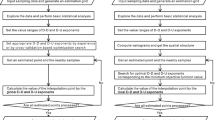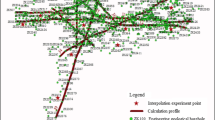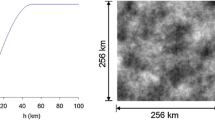Abstract
As a typical spatial interpolation method with high efficiency and simplicity, inverse distance weighting (IDW) is almost a standard estimator in numerous fields such as geosciences and environmental science. However, it ignores the data-to-data correlation, which directly leads to unfavorable estimates with irregularly distributed samples. To address this issue, we propose a novel approach, termed dual IDW (DIDW). First, the average distance from one sample to others is employed to measure the data redundancy. Second, we impose an additional exponent on the average distance to make its importance adjustable. Last, this data-to-data distance is incorporated into the traditional IDW to account for the spatial configuration of neighborhoods in the interpolation. Consequently, DIDW flexibly takes both data-to-unknown and data-to-data distances into account. Only those samples that are close to the estimated location but apart from other sampled data would be assigned with large estimation weights. Details of its application and the validity are illustrated using a case study based on the public Walker Lake dataset. Our results indicate that the developed methods not only improve the interpolation accuracy significantly compared with the traditional IDW, but also slightly outperform ordinary kriging in the case where the sample dataset is too small to capture an appropriate spatial continuity, demonstrating that DIDW is valuable to be applied in a broader context.
Similar content being viewed by others
References
Kane, V.E., Begovich, C.L., Butz, T.R., Myers, D.E.: Interpretation of regional geochemistry using optimal interpolation parameters. Comput. Geosci. 8(2), 117–135 (1982). https://doi.org/10.1016/0098-3004(82)90016-4
Ding, Q., Wang, Y., Zhuang, D.F.: Comparison of the common spatial interpolation methods used to analyze potentially toxic elements surrounding mining regions. J. Environ. Manag. 212, 23–31 (2018). https://doi.org/10.1016/j.jenvman.2018.01.074
Babak, O., Deutsch, C.V.: Uncertainty as the overlap of alternate conditional distributions. Comput. Geosci. 12(4), 503–512 (2008). https://doi.org/10.1007/s10596-008-9089-7
Liang, Q., Nittel, S., Whittier, J.C., Bruin, S.: Real-time inverse distance weighting interpolation for streaming sensor data. Trans. GIS. 22(5), 1179–1204 (2018). https://doi.org/10.1111/tgis.12458
Li, J., Heap, A.D.: Spatial interpolation methods applied in the environmental sciences: a review. Environ. Model. Softw. 53, 173–189 (2014). https://doi.org/10.1016/j.envsoft.2013.12.008
Dai, F.Q., Zhou, Q.G., Lv, Z.Q., Wang, X.M., Liu, G.C.: Spatial prediction of soil organic matter content integrating artificial neural network and ordinary kriging in Tibetan Plateau. Ecol. Indic. 45, 184–194 (2014). https://doi.org/10.1016/j.ecolind.2014.04.003
Oliver, M.A., Webster, R.: A tutorial guide to geostatistics: computing and modelling variograms and kriging. Catena. 113, 56–69 (2014). https://doi.org/10.1016/j.catena.2013.09.006
Myers, D.E.: Spatial Interpolation - an overview. Geoderma. 62(1-3), 17–28 (1994). https://doi.org/10.1016/0016-7061(94)90025-6
Goovaerts, P.: Geostatistics for natural resources evaluation. Oxford University Press, New York (1997)
Oliver, M.A., Webster, R.: Kriging: a method of interpolation for geographical information systems. Int. J. Geogr. Inf. Syst. 4(3), 313–332 (1990). https://doi.org/10.1080/02693799008941549
Fouedjio, F.: Second-order non-stationary modeling approaches for univariate geostatistical data. Stoch. Env. Res. Risk A. 31(8), 1887–1906 (2017). https://doi.org/10.1007/s00477-016-1274-y
Zhu, R., Kyriakidis, P.C., Janowicz, K.: Beyond pairs: generalizing the geo-dipole for quantifying spatial patterns in geographic fields. In: Bregt, A., Sarjakoski, T., van Lammeren, R., Rip, F. (eds.) Societal geo-innovation, pp. 331–348. Springer International Publishing, Cham (2017)
Shepard, D.: A two-dimensional interpolation function for irregularly spaced data. In: Proceedings of the 1968 23rd ACM national conference, pp. 517–524. ACM, New York (1968)
Chen, Q., Liu, G., Ma, X., Mariethoz, G., He, Z., Tian, Y., Weng, Z.: Local curvature entropy-based 3D terrain representation using a comprehensive Quadtree. ISPRS J. Photogramm. Remote Sens. 139, 30–45 (2018). https://doi.org/10.1016/j.isprsjprs.2018.03.001
Loghmari, I., Timoumi, Y., Messadi, A.: Performance comparison of two global solar radiation models for spatial interpolation purposes. Renew. Sust. Energ. Rev. 82, 837–844 (2018). https://doi.org/10.1016/j.rser.2017.09.092
Clarke, K.C.: Analytical and computer cartography. Prentice hall, Englewood Cliffs (1990)
Henderson, N., Pena, L.: The inverse distance weighted interpolation applied to a particular form of the path tubes method: theory and computation for advection in incompressible flow. Appl. Math. Comput. 304, 114–135 (2017). https://doi.org/10.1016/j.amc.2017.01.053
Isaaks, E.H., Srivastava, R.M.: An introduction to applied geostatistics. Oxford University Press, Oxford (1989)
Bartier, P.M., Keller, C.P.: Multivariate interpolation to incorporate thematic surface data using inverse distance weighting (IDW). Comput. Geosci. 22(7), 795–799 (1996). https://doi.org/10.1016/0098-3004(96)00021-0
Merwade, V.M., Maidment, D.R., Goff, J.A.: Anisotropic considerations while interpolating river channel bathymetry. J. Hydrol. 331(3-4), 731–741 (2006). https://doi.org/10.1016/j.jhydrol.2006.06.018
Nalder, I.A., Wein, R.W.: Spatial interpolation of climatic normals: test of a new method in the Canadian boreal forest. Agric. For. Meteorol. 92(4), 211–225 (1998). https://doi.org/10.1016/S0168-1923(98)00102-6
Price, D.T., McKenney, D.W., Nalder, I.A., Hutchinson, M.F., Kesteven, J.L.: A comparison of two statistical methods for spatial interpolation of Canadian monthly mean climate data. Agric. For. Meteorol. 101(2-3), 81–94 (2000). https://doi.org/10.1016/s0168-1923(99)00169-0
Tomczak, M.: Spatial interpolation and its uncertainty using automated anisotropic inverse distance weighting (IDW) - cross-validation/jackknife approach. J. Geogr. Inf. Decis. Anal. 2(2), 18–30 (1998)
Zhu, R., Janowicz, K., Mai, G., Lab, S.: Making direction a first-class citizen of Tobler’s first law of geography. Trans. GIS. 23, (2019). https://doi.org/10.1111/tgis.12550
Babak, O., Deutsch, C.V.: Statistical approach to inverse distance interpolation. Stoch. Env. Res. Risk A. 23(5), 543–553 (2009). https://doi.org/10.1007/s00477-008-0226-6
Chang, C.L., Lo, S.L., Yu, S.L.: Applying fuzzy theory and genetic algorithm to interpolate precipitation. J. Hydrol. 314(1-4), 92–104 (2005). https://doi.org/10.1016/j.jhydrol.2005.03.034
Guangqiu, H., Yue, G.Z.: A genetic algorithm approach to determining optimum parameters of distance power inverse ratio method. China’s Manganese Industry. 15(3), 20–25 (1997)
Lu, G.Y., Wong, D.W.: An adaptive inverse-distance weighting spatial interpolation technique. Comput. Geosci. 34(9), 1044–1055 (2008). https://doi.org/10.1016/j.cageo.2007.07.010
Mueller, T.G., Dhanikonda, S.R.K., Pusuluri, N.B., Karathanasis, A.D., Mathias, K.K., Mijatovic, B., Sears, B.G.: Optimizing inverse distance weighted interpolation with cross-validation. Soil Sci. 170(7), 504–515 (2005). https://doi.org/10.1097/01.ss.0000175342.30164.89
Teegavarapu, R.S.V., Chandramouli, V.: Improved weighting methods, deterministic and stochastic data-driven models for estimation of missing precipitation records. J. Hydrol. 312(1-4), 191–206 (2005). https://doi.org/10.1016/j.jhydrol.2005.02.015
Greenberg, J.A., Rueda, C., Hestir, E.L., Santos, M.J., Ustin, S.L.: Least cost distance analysis for spatial interpolation. Comput. Geosci. 37(2), 272–276 (2011). https://doi.org/10.1016/j.cageo.2010.05.012
Lukaszyk, S.: A new concept of probability metric and its applications in approximation of scattered data sets. Comput. Mech. 33(4), 299–304 (2004). https://doi.org/10.1007/s00466-003-0532-2
O’Sullivan, D., Unwin, D.J.: Geographic Information Analysis, 2nd edn. Wiley, New York (2010)
Armstrong, M.P., Marciano, R.J.: Local interpolation using a distributed parallel supercomputer. Int. J. Geogr. Inf. Syst. 10(6), 713–729 (1996). https://doi.org/10.1080/02693799608902106
Achilleos, G.: Errors within the inverse distance weighted (IDW) interpolation procedure. Geocarto Int. 23(6), 429–449 (2008). https://doi.org/10.1080/10106040801966704
Li, Z., Wu, C., Zhang, X., Weng, Z., Wang, P.: Uncertainty assessment for IDW ore grade estimates. Earth Sci. 40(11), 1796–1801 (2015)
Dirks, K.N., Hay, J.E., Stow, C.D., Harris, D.: High-resolution studies of rainfall on Norfolk Island Part II: interpolation of rainfall data. J. Hydrol. 208(3-4), 187–193 (1998). https://doi.org/10.1016/S0022-1694(98)00155-3
Zimmerman, D., Pavlik, C., Ruggles, A., Armstrong, M.P.: An experimental comparison of ordinary and universal kriging and inverse distance weighting. Math. Geol. 31(4), 375–390 (1999). https://doi.org/10.1023/A:1007586507433
Clarke, K.C.: A comparative-analysis of polygon to raster interpolation methods. Photogramm. Eng. Remote. Sens. 51(5), 575–582 (1985)
Bier, V.A., de Souza, E.G.: Interpolation selection index for delineation of thematic maps. Comput. Electron. Agric. 136, 202–209 (2017). https://doi.org/10.1016/j.compag.2017.03.008
Henley, S.: Nonparametric Geostatistics. Springer, Netherlands (1981)
Deutsch, C.: DECLUS: a fortran 77 program for determining optimum spatial declustering weights. Comput. Geosci. 15(3), 325–332 (1989). https://doi.org/10.1016/0098-3004(89)90043-5
Allasia, G.: Some physical and mathematical properties of inverse distance weighted methods for scattered data interpolation. Calcolo. 29(1), 97–109 (1992). https://doi.org/10.1007/BF02576764
Tobler, W.R.: A computer movie simulating urban growth in the detroit region. Econ. Geogr. 46(sup1), 234–240 (1970). https://doi.org/10.2307/143141
Chai, T., Draxler, R.R.: Root mean square error (RMSE) or mean absolute error (MAE)? –arguments against avoiding RMSE in the literature. Geosci. Model Dev. 7(3), 1247–1250 (2014). https://doi.org/10.5194/gmd-7-1247-2014
Efron, B., Gong, G.: A leisurely look at the bootstrap, the jackknife, and cross-validation. Am. Stat. 37(1), 36–48 (1983). https://doi.org/10.1080/00031305.1983.10483087
Marcotte, D.: Generalized cross-validation for covariance model selection. Math. Geol. 27(5), 659–672 (1995). https://doi.org/10.1007/BF02093906
Li, Z., Zhang, X., Clarke, K.C., Liu, G., Zhu, R.: An automatic variogram modeling method with high reliability fitness and estimates. Comput. Geosci. 120, 48–59 (2018). https://doi.org/10.1016/j.cageo.2018.07.011
Acknowledgments
The authors are grateful to two anonymous reviewers and Dr Daniel M. Tartakovsky for their valuable comments on the manuscript. We thank Dr Keith C. Clarke, Dr Gang Liu, and Dr Gregoire Mariethoz for their generous support in this research.
Funding
This research was supported by the National Natural Science Foundation of China (No: 41202231, 41972310 and U1711267), China Scholarship Council (No: 201606415064), and Guizhou science and technology project (No: [2017]2951).
Author information
Authors and Affiliations
Corresponding author
Additional information
Publisher’s note
Springer Nature remains neutral with regard to jurisdictional claims in published maps and institutional affiliations.
Electronic supplementary material
ESM 1
(DOCX 5324 kb)
Rights and permissions
About this article
Cite this article
Li, Z., Zhang, X., Zhu, R. et al. Integrating data-to-data correlation into inverse distance weighting. Comput Geosci 24, 203–216 (2020). https://doi.org/10.1007/s10596-019-09913-9
Received:
Accepted:
Published:
Issue Date:
DOI: https://doi.org/10.1007/s10596-019-09913-9




